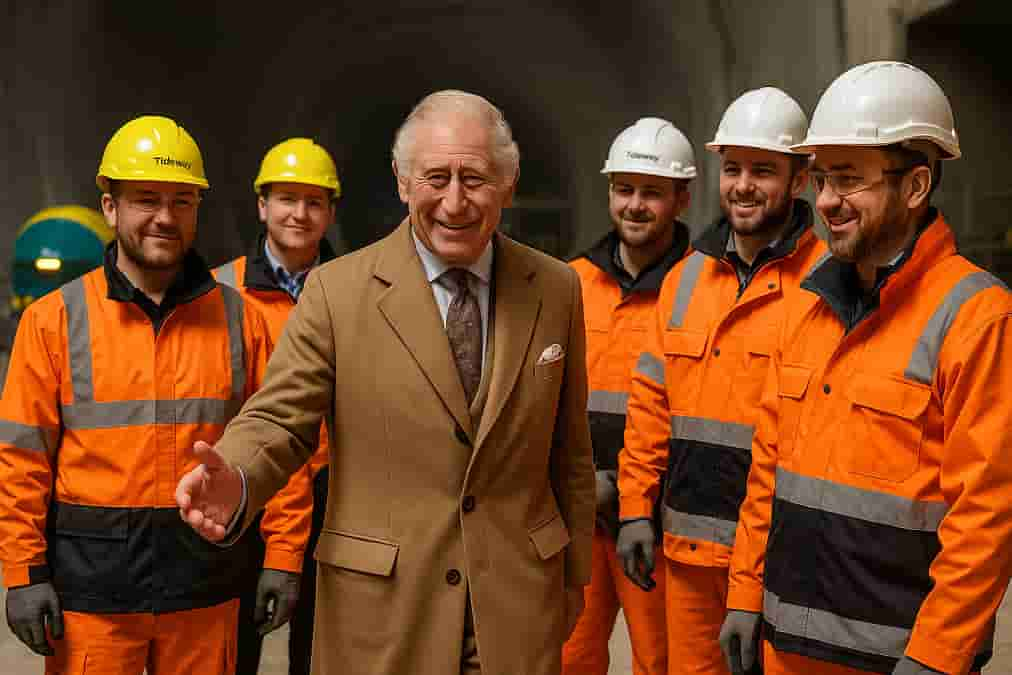King Charles III visited London’s state-of-the-art Thames Tideway Tunnel on Wednesday, jokingly warning workers of a “humongous horror” of rain as he marked the near-completion of one of the most ambitious infrastructure undertakings in recent British history.
The visit comes as the capital prepares to launch the £4.5 billion “super sewer” project, set to transform how London handles its wastewater for generations to come. The Tideway Tunnel, a sprawling 25km underground system running from Acton in the west to Beckton in the east, aims to reduce sewage pollution in the River Thames by a staggering 95%.
The King, appearing in good spirits, toured the Embankment-based project hub, where he met construction workers, engineers, and storemen involved in delivering the vast environmental improvement scheme. Addressing some of the on-site UK workforce, he quipped about the system’s reliance on heavy rainfall to assist operations: “Don’t worry, it’s all going to come in one humongous horror.”
A monumental feat of modern engineering
Taking more than a decade from conception to near-completion, the Thames Tideway Tunnel has been lauded as one of the largest engineering projects the capital has seen in recent memory. Built by a UK workforce of over 20,000 individuals, the sewer stretches beneath central London with a main tunnel diameter of 7.2 metres—enough to fit three double-decker buses side by side.
Two additional connection tunnels, five and two metres in diameter respectively, help form a sophisticated network designed to intercept and reroute combined stormwater and sewage waste. In total, the system boasts a holding capacity of 1.6 million cubic metres.
Once fully operational, the Tideway Tunnel will be managed by Thames Water, integrating with the wider London wastewater infrastructure to help protect the River Thames from frequent overflows—an environmental challenge dating back to the Victorian era.
Royal recognition and community culture
His Majesty arrived at the site via the Mars Clipper, an Uber Boat ferrying passengers across the Thames. Greeting a cheering crowd aboard a nearby vessel, Charles paused to wave and share a laugh with Uber Boat chief executive Sean Collins, asking if the service runs year-round. Their exchange offered a humanising touch to an otherwise technically dense occasion.
Among the cultural elements of the visit, the King met poet Dorothea Smartt, whose work celebrating the river’s legacy is now displayed on ventilation columns across the site. “Have you done a different poem on each one?” the King asked with interest, highlighting his attention to detail and appreciation for the artistic contributions woven into the infrastructure.
Tideway CEO Andy Mitchell guided the tour, later reflecting: “The King was fascinated with the detail, the quality, the humanity of the space. The team was absolutely thrilled the King commented on the quality. There’s huge passion here.”
An environmental turning point for London
The Thames Tideway Tunnel has been driven by an urgent need to modernise London’s wastewater handling, especially as outdated systems have led to the regular discharge of untreated sewage into the Thames. During periods of heavy rainfall, the city’s Victorian-era sewers are often overwhelmed, releasing waste directly into the river.
With the super sewer nearly ready for full-scale operation, London’s residents can expect cleaner waterways, reduced health risks, and improved biodiversity along the capital’s iconic river. The system also aligns with national efforts to meet environmental targets and support climate resilience infrastructure.
The Workers Union Says…
“This brilliant innovate project, privately financed and carried out in partnership with government support, marks a clear pivot toward long-term sustainability. It also sends a strong signal that investment in large-scale infrastructure can yield environmental, cultural, and social dividends—backed by technical precision and an enthusiastic UK workforce.”




